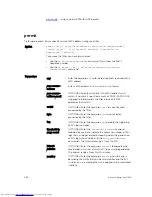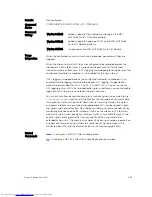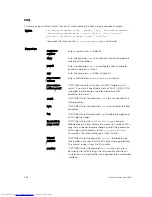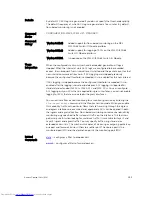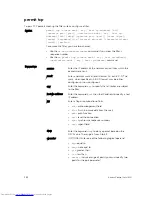
Usage
Information
The
order
option is relevant in the context of the Policy QoS feature only. For
more information, refer to the “Quality of Service” chapter of the
Dell Networking
OS Configuration Guide
.
When you use the
log
option, the CP processor logs details about the packets that
match. Depending on how many packets match the log entry and at what rate, the
CP may become busy as it has to log these packets’ details.
The
monitor
option is relevant in the context of flow-based monitoring only. For
more information, refer to
Port Monitoring
.
You cannot include IP, TCP, or UDP filters in an ACL configured with ARP filters.
When the configured maximum threshold is exceeded, generation of logs is
stopped. When the interval at which ACL logs are configured to be recorded
expires, the subsequent, fresh interval timer is started and the packet count for that
new interval commences from zero. If ACL logging was stopped previously
because the configured threshold is exceeded, it is re-enabled for this new interval.
If ACL logging is stopped because the configured threshold is exceeded, it is re-
enabled after the logging interval period elapses. ACL logging is supported for
standard and extended IPv4 ACLs, IPv6 ACLs, and MAC ACLs. You can configure
ACL logging only on ACLs that are applied to ingress interfaces; you cannot enable
logging for ACLs that are associated with egress interfaces.
You can activate flow-based monitoring for a monitoring session by entering the
flow-based enable
command in the Monitor Session mode. When you enable
this capability, traffic with particular flows that are traversing through the ingress
and egress interfaces are examined and, appropriate ACLs can be applied in both
the ingress and egress direction. Flow-based monitoring conserves bandwidth by
monitoring only specified traffic instead all traffic on the interface. This feature is
particularly useful when looking for malicious traffic. It is available for Layer 2 and
Layer 3 ingress and egress traffic. You may specify traffic using standard or
extended access-lists. This mechanism copies all incoming or outgoing packets on
one port and forwards (mirrors) them to another port. The source port is the
monitored port (MD) and the destination port is the monitoring port (MG).
NOTE: When ACL logging and byte counters are configured simultaneously,
byte counters may display an incorrect value. Configure packet counters with
logging instead.
permit ether-type (for Extended MAC ACLs)
Configure a filter that allows traffic with specified types of Ethernet packets. This command is supported
only on 12-port GE line cards with SFP optics. For specifications, refer to your line card documentation.
Syntax
permit ether-type
protocol-type-number
{
destination-mac-address
mac-address-mask
| any} vlan
vlan-id
{
source-mac-address mac-
Access Control Lists (ACL)
239


























